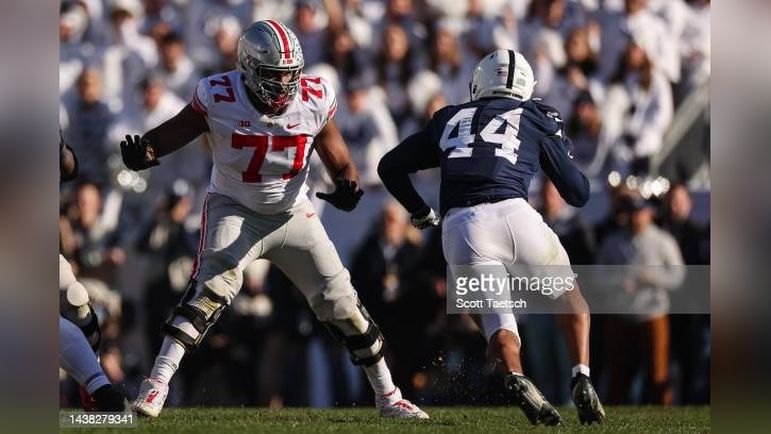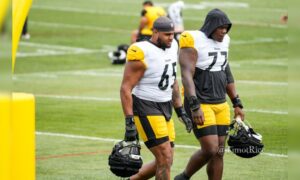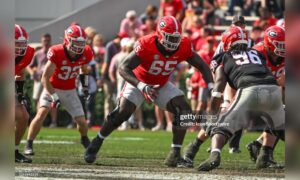As the 2023 NFL Draft approaches, it is anyone’s guess who the Pittsburgh Steelers will select at pick 17 or pick 32. Many believe the team will opt to select an offensive lineman to shore up the trenches, and protect their potential franchise quarterback in Kenny Pickett. While the Steelers’ offensive line wasn’t terrible, it could certainly use an upgrade, especially if it’s a prospect the team believes to have All-Pro potential in the first round.
Building off of a Saturday article on potential first-round offensive line prospects’ run blocking, this article will present data on pass blocking. The data is obtained from Pro Football Focus’ premium stats, and includes the grades of six potential first-round prospects. The first table includes all pressures the prospects allowed (the total of hits, hurries, and sacks), their total pass-blocking snaps, penalties, and PFF pass blocking grade.
| Snaps | Pass Blocking Grade | Pressures Allowed | Penalties | |
| Peter Skoronski OT/Northwestern | 474 | 93.0 | 6 | 2 |
| Paris Johnson OT/Ohio State | 449 | 77.9 | 14 | 0 |
| O’Cyrus Torrence OG/Florida | 355 | 76.1 | 8 | 0 |
| Broderick Jones OT/Georgia | 470 | 84.1 | 9 | 1 |
| Anton Harrison OT/Oklahoma | 447 | 83.3 | 9 | 4 |
| John Michael Schmitz IOL/Minnesota | 302 | 81.0 | 8 | 1 |
| Cody Mauch OT/North Dakota State | 304 | 81.7 | 9 | 1 |
When looking at this data, it is important to mention that it does not account for level of competition. Indeed, Georgia’s Broderick Jones and Florida’s O’Cyrus Torrence played in the SEC while Oklahoma’s Anton Harrison played in the Big 12. As such, they faced different competition than Ohio’s Paris Johnson, Northwestern’s Peter Skoronski, and Minnesota’s John Michael Schmitz, who played in the Big 10.
With all of that, based on the raw data, Skoronski is the best pass blocker of the group. He allowed the least pressures and had the best grade with the highest number of snaps. Meanwhile, Johnson, who played in the same conference, notably had a relatively low pass blocking grade. That said, neither tackle prospects are unlikely to be available at pick 17 for Pittsburgh. Moreover, Kendrick Green’s left guard position is arguably more likely to be replaced than Dan Moore’s left tackle position, as Green is on an expiring contract and the team appears committed to Moore’s development.
The second graph features each prospect’s performance in “true pass sets.” This PFF data omits screen plays, play-action passes, and rollout passes, as PFF found them to be unreliable measures of overall pass blocking performance. Indeed, teams with a poor offensive line are more likely to run said plays, and eliminating them from the data helps create a better dataset. This also takes into account the number of rushers and time to throw. That is, this only accounts for plays with more than a three-man rush to yield a greater share of one-on-one snaps to the data where the lineman did not get help. In terms of time to throw, this data only includes snaps with the quarterback having between two to four seconds to throw, as a PFF study found that time interval to be the most stable for offensive linemen to sustain their blocks.
| Total Snaps | True Pass Set Grade | True Pass Set Pressures Allowed | |
| Peter Skoronski OT/Northwestern | 183 | 92.3 | 2 |
| Paris Johnson OT/Ohio State | 175 | 73.7 | 8 |
| O’Cyrus Torrence OG/Florida | 122 | 64.5 | 6 |
| Broderick Jones OT/Georgia | 139 | 76.2 | 6 |
| Anton Harrison OT/Oklahoma | 91 | 73.5 | 5 |
| John Michael Schmitz IOL/Minnesota | 106 | 75.6 | 4 |
| Cody Mauch OT/North Dakota State | 100 | 82.0 | 4 |
In true pass sets, the majority of the prospects in question’s play noticeably fell. The only two players to not see a big fall in their play are Skoronski and Mauch. For Skoronski, 38% (183/474) of his snaps came in true pass sets, and his PFF grade hardly suffered. For Mauch, who had around a third of his snaps (100/304) come from true pass sets, actually saw his grade improve in said situations.
Harrison played the lowest amount and percentage of true pass sets (20% at 91/447), and saw his grade decline while allowing the majority of his pressures (5/9) in said snaps. Johnson, Torrence, and Jones also allowed the majority of their pressures in a fraction of snaps in true pass sets, and also saw their blocking grade decline. The biggest decline was from Torrence, who allowed six of his eight pressures, and saw his grade decline by more than ten in true pass sets.
Needless to say, the data is far from a comprehensive outlook on these prospects, and is mainly meant to add context to their play. To get a better look on said prospects, be sure to check out the site’s draft profiles.
What are your takeaways from this data? Comment below!








